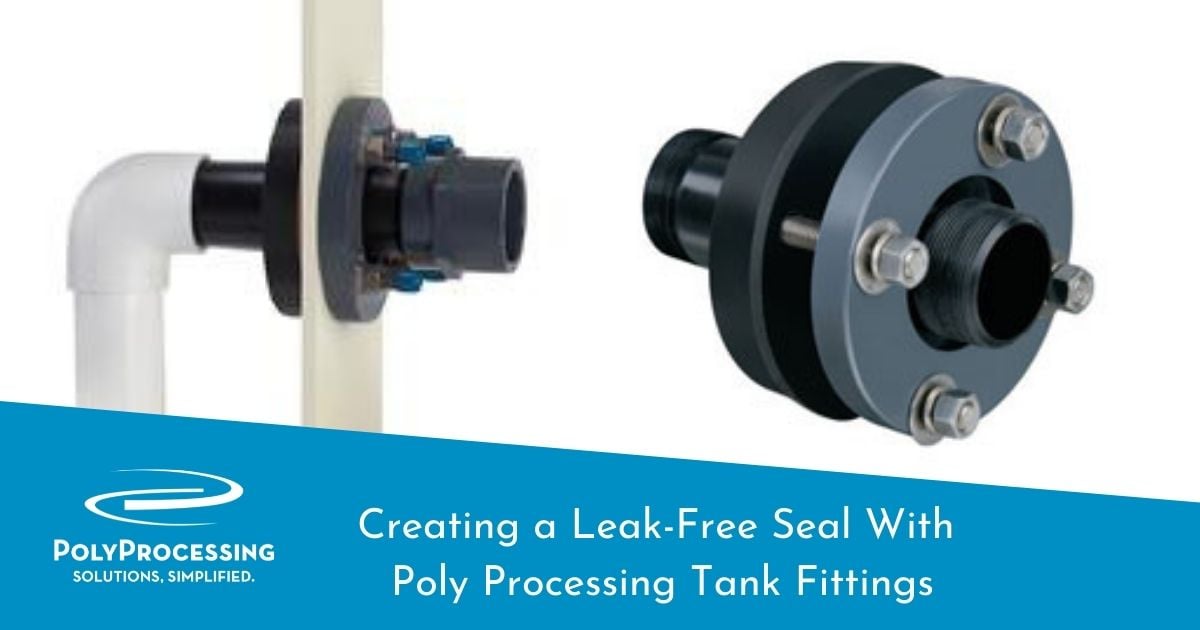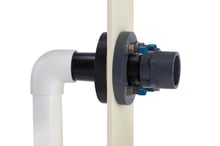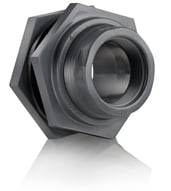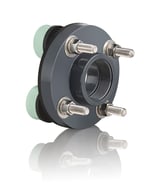Creating a Leak-Free Seal With Poly Processing Tank Fittings
Rather than settle for the industry standard, Poly Processing redefines the standard by developing fittings and tank accessories that clearly address our customers’ needs. By analyzing industry requirements and working directly with our customers, we gain the insights to develop specialized products that address real-life issues in the field.

With more than 50 years of chemical storage experience, we understand the importance of using the right storage components for your application. We’ve learned how to build the right high performance chemical storage systems for chemicals like sulfuric acid, sodium hypochlorite, hydrochloric acid, alum, F.O.G., PAA, etc.
Let's look at three common fitting types used in our chemical storage tanks and how they work.
Fittings Molded as Part of the Tank
Poly Processing’s proprietary Integrally Molded Flanged Outlet (IMFO) is a completely full discharge fitting molded while the chemical storage tank is processing, making it a stress-free part of the tank. The flange is created from the same material as the tank — it’s not an insert introduced during or post-production.
The biggest benefit of the IMFO tank is that there is no weak point in the fitting as it is molded as part of the tank rather than added later. So how does it seal?
The flange itself is faced off or surfaced at the factory so that it is smooth. To seal the fitting, a gasket is placed on the face of the IMFO with the flange against it and the two are bolted together as one assembly.
This configuration has been carefully engineered to minimize the risk of leaks or spills from the day the chemical tank is built. One big benefit for this configuration is the entire assembly is external and not bolted through the tank wall.
 Bolted One-Piece Sure Seal (B.O.S.S.) Fittings®
Bolted One-Piece Sure Seal (B.O.S.S.) Fittings®
With its streamlined one-piece design, the B.O.S.S. Fitting reduces the seal point to a single gasket to greatly reduce the chances of a leak.
This unique fitting:
- Is constructed of polyethylene for chemical compatibility with your chemical storage tank.
- Has an innovative, polyethylene encapsulated, backing ring design to reduce stress on the fitting and make it three times stronger than plastic fittings.
- Is easy to maintain since the pipe connection is extended beyond the sidewall of the tank.
- Is available in 1, 2 and 3 inches I.D. with PVC or CPVC socket connection.
The B.O.S.S. Fitting is available in three alloy options: 316 stainless steel, titanium and C-276. It comes fully assembled and factory installed.
Bulkhead Fittings
An economical option best used on small tanks or specific applications are the plastic bulkhead fittings, which are available in PVC, CPVC, and Polypropylene.

The bulkhead fittings seal by drilling a single hole into the sidewall of the tank. The installer places a ring gasket onto the bulkhead fitting, and it goes from the inside of the tank to the outside through the hole. A compression nut then threads onto the bulkhead fitting, is tightened up and is sealed.
Note: Because of the lack of torque value on most plastic fittings, this type of fitting is limited. It's used on smaller tanks and also for overflow connections on tanks 3,000 gallons or larger.
Besides PVC, another type of bulkhead fitting is stainless steel. These do have bolts that share a common stainless steel back plate inside the chemical storage tank. Here, there is a single gasket that goes on the fitting. To seal it, you drill the bolt and fitting holes, and the stainless steel bulkhead with the gasket comes from inside the tank out with a compression plate bolted down on the outside. This is by far one of the strongest fitting choices, but stainless steel isn’t compatible with certain chemicals.

Lastly, there's a bolted flange fitting which is a little more complex. Similar to the IMFO fitting, the gasket goes on the outside with the PVC flange. On the inside of the tank, it is married to bolts with welded washers and encased in plastic. These bolts come through the tank and have their own smaller gaskets to seal the bolt holes. In the end, the bolt holes seal from the inside and the actual fitting seals from the outside.
Need Help Choosing a Tank Fitting?
When you are selecting the fittings for your chemical tank system, it is important to make sure they are engineered for your specific application. Let us help ensure the chemical storage system is safe and reliable. For more information on Poly Processing's fittings contact a chemical storage tank system expert today.
To ensure all fittings are properly installed to be leak-free, view our Installation, Operation, and Maintenance Manual.
- September 2, 2024
- Topics: Fittings and Accessories
About Poly Processing
Posts By Topic
Tech Talk Podcast Episodes
Subscribe By Email
Recent Posts
- Choosing Between Steel, Polyethylene, and Fiberglass Tanks: What You Need to Know
- Getting Your Plastic Tank Foundation Right: Why Professional Design Matters
- What to Expect in Lead Times for Chemical Storage Tanks: Planning Ahead
- The New 10,500-Gallon SAFE-Tank: Setting a New Standard for Chemical Storage Safety
- How Proper Mixing and Agitation Systems Prevent Chemical Separation in Storage Tanks
Tank Configurator

Find the recommended tank and system components for your chemical storage challenge.
Configure a Tank Package







